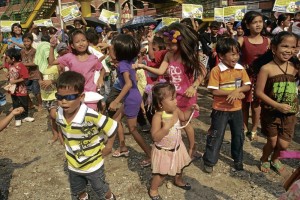
KIDS show the safe way to welcome the coming of 2013—grooving to the tune of “Gangnam Style”—as part of a campaign to dissuade the public against lighting firecrackers on New Year’s Eve. JOAN BONDOC
Children wearing masks on Sunday blew paper horns, shook makeshift maracas and danced to the hit song “Gangnam Style” in front of a church in Malate, Manila, to call for a New Year celebration free of firecracker emissions.
Noting that every year, the public is warned about the danger posed by pyrotechnic materials to their lives or limbs, a group of doctors, environmentalists, priests and church goers chose to emphasize the health threat that come from exposure to fireworks.
These include respiratory problems such as bronchial asthma, pneumonia and laryngitis, pulmonologist Dr. Maricar Limpin, former president of the Philippine College of Chest Physicians (PCCP), said in a statement.
“The marked increase of particulate matter in the atmosphere can cause nose, throat, chest and eye problems and aggravate the condition of people suffering from allergies, coughs and colds,” she noted.
At the same time, EcoWaste Coalition—the environmental watch group behind Sunday’s “Iwas Paputoxic (Avoid Toxic Firecrackers)” campaign which was conducted together with PCCP, Philippine Medical Association and the Our Lady of Remedies Parish—expressed concern over the “very unhealthy” air quality in Metro Manila after the 2011 New Year celebration.
“The pyrotechnic explosions create a toxic brew of injurious pollutants affecting the air quality and consequently the health of people, particularly infants and young children and those afflicted with heart and respiratory diseases,” Aileen Lucero of EcoWaste Coalition said in a statement.
On Jan. 1, 2012, nine monitoring stations recorded an average of 352 ug/m3 of particulate matter, far above the 24-hour guideline value of 150 ug/m3, according to data cited by the Department of Environment and Natural Resources’ Environmental Management Bureau.
As for total suspended particulate (TSP), eight of the nine monitoring stations registered levels above the 24-hour guideline value of 230 ug/m3. The average TSP recorded by the eight stations was 477.67 ug/m3.
The group urged the government to monitor the air quality on New Year’s Eve until Jan. 1, 2013, and release the generated data as well as issue appropriate advisories based on the air quality index.
At the same time, EcoWaste Coalition supported the call of the National Parks Development Committee (NPDC) to keep Rizal Park in Manila free of trash on New Year’s Day, following reports that visitors who went there on Dec. 25 left behind 50 truckloads of garbage.
Earlier, NPDC officials sought the cooperation of around four million people who were expected to go to the park to take part in festivities marking the start of 2013.
“We join the park authorities in reminding people who are planning to gather in Rizal Park for the New Year’s countdown to treat the place with the highest respect … by not littering,” said Romy Hidalgo, a member of EcoWaste’s steering committee and its representative to the National Solid Waste Management Commission.
According to the NPDC, some 500,000 park goers left 50 truckloads of garbage on Dec. 25.
“Things you bring to the park need to come back with you for proper recycling or disposal and should never be left behind,” Hidalgo said in a statement.
“Let us not turn the sprawling green space of Rizal Park into a carpet of garbage such as discarded plastic bags, food containers and wrappers and meal leftovers,” he added.
EcoWaste also asked the park management and the public to strictly observe Rizal Park’s “no smoking, no littering” policy as it stressed that a place for rest and recreation should be entirely free of cigarette smoke and litter.
Those caught littering or smoking within the park premises will be fined P500 or required to render eight hours of community service for the first offense, a fine of P1,000 to 5,000 or 16 hours of community service for the second offense and a fine of P5,000 to 10,000 for the third offense, the group said.
“The festive season is not an excuse to bury Rizal Park in holiday trash. Littering by itself can never be justified,” Hidalgo said.